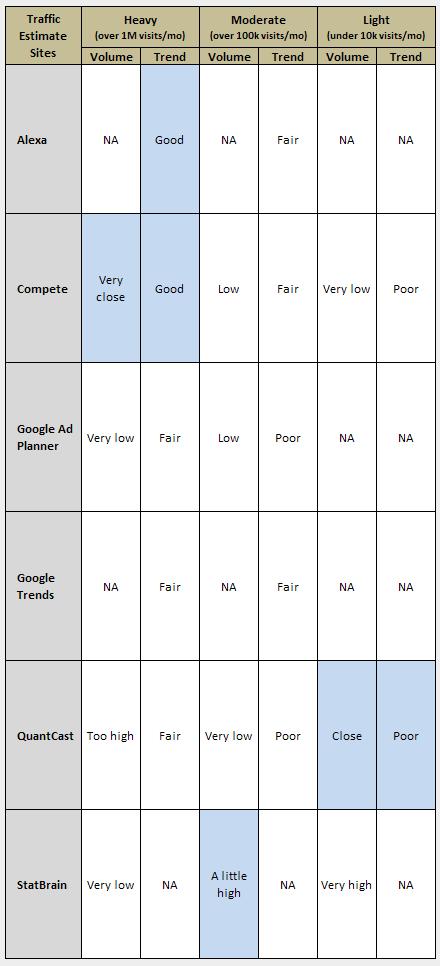There are several reasons why an online marketer wants to know how much traffic a site other than their own is receiving:
- You may want to compare how much traffic a competitors’ site is getting.
- In reviewing the landscape of sites your target customers are visiting, you may want to ballpark the volume of traffic to each in order to get a sense of their relative prominence.
- When reviewing the sources of traffic to your website, you may identify a new source that has had good conversion success and you may want to determine if they have a significant audience and would like to see if that audience is growing. If so, you may want to pursue a more in-depth relationship with that source.
- It may also help to provide focus in trying to establish high quality links to your site for SEO purposes.
There are now several free traffic estimation services (Amit Agarwal did a nice job of outlining these options in his article, Find Out How Much Traffic a Website is Getting). However, one obvious question is how accurate is the data?
In order to help answer that question, we evaluated the quality of these estimation services against the web analytics data collected through Omniture, Google, etc. for a subset of our clients. We thought that the quality of those estimates might vary significantly depending upon how heavy the volume of traffic was to the site being estimated. As such, we grouped the results based on site activity: heavy, moderate, and light. When available, we also evaluated how accurately the services reflected the trend of the site traffic as well as the volume of visits and visitors for the following traffic estimation services: Alexa, Compete, Google Ad Planner, Google Trends, QuantCast, and StatBrain.
The following table shows how the free sources compared to the data collected by our clients’ analytics programs (e.g. Compete’s estimation of traffic for moderate sites was lower than reported by the analytics tools used by those sites).

I should note that this was not a formal study, was based upon a relatively small sample set, and other factors may impact the results (e.g. relative volume of paid search marketing may influence the accuracy of some sites versus others).
A few observations/conclusions:
- Not surprisingly, the quality of the estimates is considerably better for higher volume websites.
- At this point, there does not seem to be a reliable source for viewing site trends for lower volume websites and the trends for moderate traffic websites are not much better.
- The growing volume of incremental demographic information being provided by some of these services is encouraging. Most of the demographic information is fairly rudimentary, but it is definitely more than what has been available in the past.
- You should definitely review Dataopedia.com. In addition to pulling in data from Alexa, Compete, and QuantCast, this service displays other non-traffic related data such as Google Page Rank and Twitter posts related to the site.
- Given that none of the free services provided accurate estimates in every scenario, you may be able to use our findings to make adjustments for your specific situation.
Has anyone else conducted a similar comparison? If so, what type of results did you find?
 Too often there is a discussion about which is the ‘best’ online marketing tactic or channel (e.g. Facebook vs. Twitter or social vs. email) as if we can only choose one. As marketers, we need to focus on having conversations with our consumers how they want and where they want. For some, that is still email and for others it might be Twitter, Facebook, or something entirely different. The more places we can be providing relevant content and useful information, the more successful we will be.
Too often there is a discussion about which is the ‘best’ online marketing tactic or channel (e.g. Facebook vs. Twitter or social vs. email) as if we can only choose one. As marketers, we need to focus on having conversations with our consumers how they want and where they want. For some, that is still email and for others it might be Twitter, Facebook, or something entirely different. The more places we can be providing relevant content and useful information, the more successful we will be.
